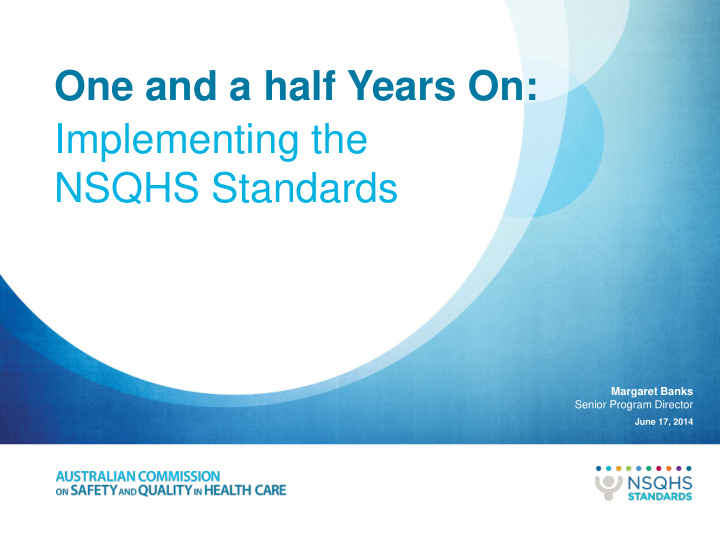



One and a half Years On: Implementing the NSQHS Standards Margaret Banks Senior Program Director June 17, 2014
Accreditation Outcomes 1352 health services to be assessed to the NSQHS Standards • 730 public hospitals • 290 private hospitals • 299 day procedure services • 33 other services Additional services: Community health services Public dental services Prisons health services Mother and baby care services
Accreditation in 2013 Total accredited nationally Jan 2013 – December 2013 • 750 health services assessed • 333 public health services (46% of 770 total services) • 417 private health services (54% of 770 total services) • 453 were assessed to Standards 1-3 • 279 were assessed to Standards 1-10 • 18 new services completed interim accreditation
Accreditation in 2014 Total accredited nationally Jan 2014 – August 2014 • 530 health services assessed • 276 public health services (52% of 345 total services) • 254 private health services (48% of 345 total services) • 208 were assessed to Standards 1-3 • 314 were assessed to Standards 1-10 • 8 new services completed interim accreditation
Core actions not met at org. wide assessment as a percentage of total actions in each Standard (2013 and Jan to July 2014) 2013 data 2014 data
Are the NSQHS Standards making a difference? Early indications suggest: • In NSW 2010 ‘Between the Flags’ implemented in 220 NSW Hospitals. This has resulted in 38% decrease in cardiac arrests. This translates into approximately 800 fewer deaths since 2010. National similar programs are now being implemented because of the NSQHS Standards.
Are the NSQHS Standards making a difference? • Mandatory implementation of the National Inpatient Medication Chart is estimated to have improved • documentation of patient allergies and reactions; and • Reduced medicine prescribing errors in hospitals across Australia
Are the NSQHS Standards making a difference? • Combined strategies developed by the Commission, including hand hygiene, AMS and the introduction of the NSQHS Standards have resulted in a steady decrease in incidents of HAI multi resistant Staphylcoccus aureus in hospitals. Reductions are from 1.1 cases per 10,000 patient days to 0.9 cases per 10,000 patient days (p<0.001)
Implementing the NSQHS Standards in the Public Sector Areas of greatest number of not met: • 3.14 Anti-microbial Stewardship • 3.10 Aseptic Technique • 2.6 Patient centred training • 1.18 Informed consent • 3.15 Clean environment • 1.2 Quality plan
Implementing the NSQHS Standards in the Private Sector Areas of greatest number of not met: • 3.10 Aseptic Technique • 2.7 Consumer information • 3.14 Anti-microbial Stewardship • 2.8 Managing invasive devices • 2.6 Patient centred training • 3.19 Consumer information on HAI • 3.5 Hand hygiene
Health service performance (interim, mid-cycle, org wide) Met with Merit Met with Merit 2013 2014 Range – core and 0 to 116 0 to 43 developmental actions 0 to 109 0 to 32 Range – core actions Range – developmental actions 0 to 14 0 to 14 3 4 Average 0 0 Median (middle of range) 0 0 Mode (most occurring)
Range, average, media and mode for not met core actions at organisation wide assessments
Issues • Resource burden associated with auditing / monitoring • Inter-assessor reliability • Extend of evidence required by accrediting agencies • Compliance with reporting timeframes by accrediting agencies • Appropriate report of ‘significant risk’ • Consistent application of non-applicable status • Assessment of actions that don’t apply across the whole organisation • Language of the NSQHS Standards
What are we working on…… • Guide for Boards implementing the NSQHS Standards • Additional resources for Standard 2 • Clarification of Basic Life Support requirements • Advance Care Directives • Health Literacy • Cognitive Impairment • Mental Health • Falls Prevention • Improving care for Aboriginal and Torres Strait Islander people using the NSQHS Standards • Resources for Royal Flying Doctor Service • NSQHS Standards in MPSs
Evaluation of the NSQHS Standards Formal external evaluation • Consumer • Cost analysis • Evaluation of State and Territory administrative data sets pre and post Standards implementation • Longitudinal survey of attitudes Ongoing review • Accreditation outcome data • Review of Approved Accrediting Agencies • Analysis of data collected from Advice Centre, medications, surveys undertaken by the Commission External review: • Australian Institute of Health Innovation – ACCREDIT project Review of approved accrediting agencies and the approvals process
Revision of Standards • Commencing 2015 with background work underway • Collating and interpreting information from the informal and formal evaluation processes • Consider issues of basic patient care and what this may include • Evaluate finding from Standards related projects - cognitive impairment, mental health, Aboriginal and Torres Strait Islander project, community-based care, • Less is more – focusing actions on evidenced based strategies • Remove duplication and streamline
Thriving not just surviving • Standards are a framework for improvement • For each Standard focus on the things that matter to you • Audit the areas: • where harm occurs • present the greatest risk to patients • where you want to make improvements • Teach the workforce about risk, how to measure and how monitor it • Assess skills and only train where it is needed • Engage the board, executive, technical leads, clinicians and non- clinicians in the process • Don’t do it if it is just for accreditation • Use the resources that the Commission, jurisdictions have produced • Use the help that is available • Network with peer organisations • Advice Centre
Recommend
More recommend